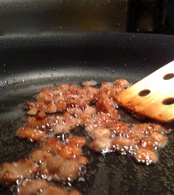|
|
 |

Aug 20, 2013
WINE WITH…Duck Breasts with Cracklings
We couldn’t have been more delighted when our Wine Review Online colleague Michael Apstein invited us for dinner one evening earlier this month as summer was rolling towards its inevitable finale. Not only is he an engaging and generous host, he is also a superb cook. Furthermore, he doesn’t hesitate to open special gems from his fine wine cellar to serve with dinner. Weren’t we the lucky guests! cook. Furthermore, he doesn’t hesitate to open special gems from his fine wine cellar to serve with dinner. Weren’t we the lucky guests!
After a first course of lobster and corn salad, Michael dished up tender and tasty grilled duck breasts garnished with little nuggets of crispy, crunchy bits of duck skin that had been rendered in their own fat, each bite exploding in the mouth with richness and flavor. You may think of these tasty morsels as cracklings, or if you speak Yiddish, gribenes.
Back home, we didn’t have anything tucked away in our own cellar that rivaled the incomparable 1979 Guigal Côte Rôtie “La Landonne” that Michael poured for us that evening, but we focused on current releases and managed to find a number of wines that tasted delicious with this dish.
Duck Breast with Cracklings
Serves 2
2 duck breast halves, about 6 ounces each
1 tablespoon olive oil
Salt and fresh ground pepper
1 teaspoon herbes de Provence (or make your own blend of dried thyme,
oregano, basil, marjoram, rosemary, and the like)
Instead of grilling, you can roast the duck breasts in a 400° oven. The best thing to serve with the duck is diced potatoes sautéed in the fat that was rendered from the cracklings. If you want something simpler to accompany this fairly rich dish, however, go with a big green salad and/or a tomato salad. In that case, freeze the duck fat for another use.
Instead of grilling, you can roast the duck breasts in a hot oven.
An hour or two before serving, peel the layer of skin and fat from the duck breasts, using a small, sharp knife and trying to keep the meat as intact as possible (this is usually a simple enough process as the skin lifts off easily with only a little cutting required here and there). Place the breasts on a plate and brush them on both sides with the olive oil, and season with salt and pepper. Sprinkle the herbs on one side of the breasts, cover them lightly and refrigerate until ready to cook.
Meanwhile, dice the skin into ¼ to ½ inch pieces. Place them in a sauté pan (nonstick works fine) and cook over medium heat, stirring frequently, until they are golden brown. Remove with a slotted spoon and drain on paper towels. (If you are going to fry potatoes, just use the same pan, otherwise pour the fat into a container and freeze for another use).
Heat your grill (or preheat your oven), and good the duck breasts, with the herb covered side facing up, over indirect but high heat. With the skin removed, the meat will be quite lean, so be careful not to overcook. You’ll want it rosy on the inside.
Slice the meat thinly, arrange on serving plates, and scatter the cracklings over the top. Serve immediately.
* * *
We tried twelve wines with this dish, nine red, two white and a single rosé. The whites, even a powerful oak-tinged Chardonnay, tasted washed out with it, as did a couple of the lighter-bodied reds. The rosé proved refreshing, and we’d especially recommend a wine of its ilk on a hot summer evening, but in general the dish did best with full, hearty reds. Bright fruit flavors worked well, as did spicy, herbal undertones, but the most important factor turned out to be texture, as this fulsome, meaty dish clearly pairs best with equally meaty wines.
Selection
|
Approx. Price
|
Comments
|
Clarksburg Wine Company, Clarksburg (California) Petite Sirah 2010
|
$26
|
A delectable Petite, without excessive tannin but plenty of bold, assertive personality, this wine made for a youthful and extremely juicy match.
|
Frei Brothers, Dry Creek Valley (California) Merlot “Reserve” 2011
|
$20
|
An excellent partner for the grilled duck, this Merlot shows plenty of bright fruit with a seductive hint of oak. It tasted fruit-filled but not sweet, and was a wine we kept returning to throughout the meal.
|
Laurent Miquel, Faugéres (France” “L’Artisan” 2011
(Imported by Miquel et Fils)
|
$16
|
A blend of 80% Syrah and 20% Grenache, this southern French red tastes of plum-like fruit with a distinct undercurrent that resembles dried herbs, much like those used to season the duck. No wonder it worked so well as a partner.
|
Rancho Zabaco, Sonoma County (California) Zinfandel “Sonoma Heritage Vines” 2011
|
$18
|
Showing less sweetness than most contemporary Zins, this brambly Californian tasted lively and seductive. Its forward character matched the unabashed and seductive personality of the dish.
|
Tablas Creek Vineyard, Paso Robles (California) “Patelin de Tablas Rosé” 2012
|
$20
|
Like the reds we are recommending, this salmon-colored rosé is full of fruit and very lively. It’s lighter than those other wines, but is full of sunny, warm weather charm.
|
|
 |
|